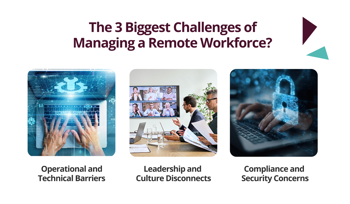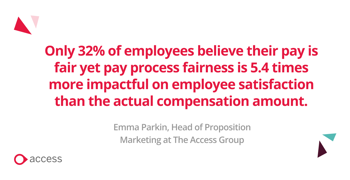
What is remote workforce management?
Remote workforce management involves strategically coordinating and supporting employees outside traditional office settings. In large organisations, this requires robust processes, technologies, and policies that help promote productivity, engagement, and compliance across distributed teams. Some of the key responsibilities for organisations include:
- Communication Oversight: Ensuring smooth information flow from leadership to daily operations.
- Performance Tracking: Using new metrics to assess productivity without relying on physical presence.
- Compliance Management: Navigating diverse regulations across jurisdictions.
- Employee Engagement: Creating strategies to foster connection and motivation remotely.
Enterprise vs. SMB Remote Work Models
Remote work looks very different in enterprises compared to SMBs. Whilst smaller companies may rely on informal check-ins and basic tools, enterprises need structured governance, standardised processes, and integrated tech systems to manage thousands of employees. Some of the challenges that are unique to enterprises include:
- Global Coordination: Managing time zones and asynchronous collaboration.
- Legal Complexity: Adhering to varied employment laws and data regulations.
- Security: Ensuring secure remote access across multiple platforms.
- Governance: Developing consistent policies that allow for regional flexibility.
Informal approaches that work for SMBs can lead to risks and inefficiencies at scale, making formal frameworks essential for large organisations.
How remote work has changed the workforce
The shift to remote work has meant that enterprises need to change their approach talent management, organisational structure, and workplace culture.
The Rise of Global Talent Pools
Remote work has made it easier than ever to hire people from anywhere. UK companies can now bring in talent from across Europe, Asia, and beyond, often gaining access to rare skills and reducing costs.
But managing international teams isn’t simple. Different countries mean different laws, payroll systems, and tax rules. It also means bringing together varied cultures, communication styles, and work habits into one cohesive team.
Time zones are another challenge. A global team needs thoughtful planning, like rotating meeting times and using async tools, to keep everyone included and productive.
Redefining Productivity and Collaboration
For the most part, businesses have moved away from measuring productivity by hours at a desk. Now it’s about results. Teams are working more asynchronously, contributing when it suits them, and using digital-first meetings that are often more focused and efficient than in-person ones.
AI is helping too. Most workers now use AI to save time, stay focused, and be more creative. Microsoft / LinkedIn 2024 WTI reports that 75% of workers us AI. That number has likely grown throughout 2025. But to get the most out of it, companies need to invest in training and roll it out in a way that works for everyone.
The Evolution of Work Culture
Employee expectations have shifted with flexibility now being an essential part of the offering. People want work to fit into their lives. That means rethinking how we measure performance, schedule meetings, and communicate across teams.
Wellbeing is also a leading issue that large businesses focus on. Leading companies can tackle burnout and isolation with strong support systems and thoughtful policies. To learn more about burnout and how to support workers experiencing, read our guide to ‘Addressing Burnout in Finance.’
Looking ahead, hybrid work is likely to stay. Most large UK organisations are settling into a rhythm of two to three office days per week, though the details will vary depending on the industry and what employees need.
Expert Insight
Emma Parkin, Head of Propositions at The Access Group, tackles the complexities of hybrid work environments and how to get them right.

What are the 3 biggest challenges of managing a remote workforce?
Managing a remote workforce at scale can bring a range of challenges. While every organisation is different, three common areas tend to cause the most friction: operational barriers, leadership disconnects, and compliance concerns. If left unaddressed, these issues may impact productivity, engagement, and trust.
1. Operational and Technical Barriers
Remote work depends heavily on reliable tech. Remote work depends heavily on reliable tech, but many organisations still face challenges. In large companies, 65% of employees report feeling overwhelmed by complex workplace technology, and 59% would consider quitting if systems are too difficult to use. (Petri)
Tool overload is another common issue. When employees juggle multiple platforms for messaging, project tracking, and performance reviews, it can create friction and reduce focus.
Legacy systems may also struggle to integrate with newer remote work tools, leading to data silos and fragmented workflows.
To help, organisations may benefit from unified platforms that bring key functions together. Centralised IT support hubs focused on remote work can also improve response times and reduce frustration.
2. Leadership and Culture Disconnects
Remote work can make it harder for leaders to stay visible and connected. Without regular in-person contact, managers may find it difficult to assess performance, build trust, or maintain team cohesion.
The absence of informal interactions, like hallway chats or spontaneous brainstorming, can weaken company culture. This may lead to slower decision-making, reduced innovation, and lower engagement.
To bridge the gap, organisations can run virtual town halls, encourage skip-level meetings, and create spaces where leaders share updates and interact informally with teams. These efforts may help rebuild trust and keep culture alive in a digital setting.
3. Compliance and Security Concerns
Security and compliance can become more complex when employees work remotely. Accessing sensitive data from different locations and devices may introduce risks, especially when home networks vary in quality and security.
GDPR and other regulations may be harder to manage across borders. Employment laws, tax rules, and industry-specific requirements can differ widely, making international remote work more complicated.
Solutions may include using VPNs to secure data, deploying endpoint management systems to monitor devices, and offering regular training to help employees understand their role in keeping data safe.

How to overcome the challenges of managing a remote workforce?
Solving remote workforce challenges often requires a mix of the right tools, clear processes, and cultural shifts. Enterprise-level solutions can help by offering scalable, secure, and adaptable ways to support distributed teams.
Building a Scalable Remote Infrastructure
Cloud-based systems can provide the flexibility and accessibility remote teams need. They allow people to collaborate from anywhere and scale as the organisation grows. We’ve assessed some of the HCM systems in the UK in our guide to 'What is the best human capital management (HCM) software in the UK?’ and it can help you decide what features your remote infrastructure may require.
Centralising communication tools may reduce confusion and improve productivity. When messaging, meetings, and project tracking happen in one place, teams often work more smoothly.
Automation can also help. Tasks like onboarding, scheduling reviews, and tracking compliance may be handled more efficiently with the right tools, freeing up time for more strategic work.
IT and operations teams play a key role in keeping everything running. Some organisations choose to set up dedicated support for remote workers, often across time zones, to ensure quick help when issues arise.
Empowering Managers with Data and Tools
Managers may find it harder to support remote teams without the right visibility. People analytics platforms can help by showing patterns in productivity, engagement, and workload. This kind of insight allows leaders to make informed decisions and offer timely support.
Training for remote leadership is also important. Managing distributed teams often requires new skills, like coaching through digital channels and keeping motivation high without in-person contact. Dashboards and reporting tools can give managers a clearer view of how teams are doing.
“We’re using industrial-age tools to solve digital-age problems. And every day we persist with these broken systems, the skills gap widens, engagement drops, and our best people leave.”
Emma Parkin, Head of Proposition Marketing at The Access Group in Beyond Annual Reviews From Skills Gaps to Business Impact
Creating Clear Communication Protocols
Clear communication guidelines can make a big difference. These may include which tools to use for different types of messages, expected response times, and how to escalate urgent issues.
Documentation becomes more important when teams aren’t sharing knowledge informally. Capturing decisions, project details, and processes in accessible formats helps new team members get up to speed and keeps things running smoothly.
Meeting rhythms should be carefully planned. Regular check-ins and project reviews can help maintain connection, but too many meetings may reduce focus. Some organisations use communication playbooks to set expectations around tools, etiquette, and workflows. These can help create consistency while still allowing for flexibility across teams.
How can you manage, motivate, and engage your remote teams?
Managing remote teams well often means rethinking traditional leadership approaches. Motivation and engagement may not happen organically in distributed environments, so it helps to be intentional. Employee benefits, for example, are a strong driver of motivation and you can learn how to improve your process of implementing and promoting employee benefits in our article, ‘How to drive employee motivation, engagement and retention with flexible benefits’.
Leading with Trust and Outcomes
Managing remote teams effectively often starts with trust. Rather than focusing on hours worked or online presence, many organisations are shifting toward outcome-based leadership.
Giving employees the freedom to work in ways that suit them can boost motivation, especially when paired with regular check-ins and clear expectations. Recognition also plays a key role. In remote settings, it helps to be intentional about celebrating achievements and acknowledging contributions.
Career development also remains important. Remote employees may worry about being overlooked, so offering growth opportunities, mentoring, and feedback can help keep them engaged. Virtual events, informal catch-ups, and inclusive communication practices can help maintain team spirit and ensure everyone feels part of the conversation.
“Only 32% of employees believe their pay is fair yet pay process fairness is 5.4 times more impactful on employee satisfaction than the actual compensation amount.”
Emma Parkin, Head of Proposition Marketing at The Access Group in Strategic Compensation Management
Motivating Through Recognition and Growth
Keeping remote teams motivated often comes down to feeling valued and supported. Without the informal feedback that happens in office settings, recognition and career development may need to be more intentional. Reach PLC, one of the UK’s largest media publishers, successfully transitioned their employee recognition strategy to a digital-first model. By offering personalised gift cards and charitable donation options, they boosted engagement across a diverse, remote workforce while maintaining fairness and flexibility. Read more about their Success Story and discover how Access Employee Engagement Software can help you.
Virtual recognition platforms can help make appreciation more visible. Peer shoutouts, manager acknowledgments, and company-wide celebrations may all contribute to stronger morale.
Career growth also matters. In remote environments, opportunities may be harder to spot, so structured mentorship, clear internal mobility pathways, and personalised learning resources can help employees feel supported. HR teams may play a key role in guiding career conversations and helping individuals map out their development.
Creating Connection and Belonging Across Borders
Diversity, equity, and inclusion (DEI) strategies may need to be adapted to ensure all employees feel valued, regardless of location, background, or personal circumstances.
Remote work can either reduce or reinforce inequalities, depending on how policies are designed. Regular equity audits may help identify gaps and ensure fair access to opportunities, resources, and recognition.
Cultural sensitivity also becomes more important when teams span countries and time zones. Leaders may benefit from training that helps them understand different communication styles and work preferences, creating space for everyone to contribute effectively.
Measuring and Improving Engagement at Scale
Tracking engagement across remote teams can help leaders understand how people are feeling and where support may be needed. Metrics like Employee Net Promoter Score (eNPS), participation in voluntary activities, and feedback from regular surveys can offer useful insights. To get started, download our Employee Engagement Survey Template which is a practical resource designed to help you gather meaningful feedback and improve engagement across your teams.
Pulse surveys and feedback loops allow organisations to spot disengagement early. Short, regular check-ins can surface challenges and help measure the impact of engagement efforts. Acting on feedback quickly and transparently shows employees that their input leads to meaningful change.
People analytics can reveal patterns that aren’t always visible, such as links between engagement and workload, communication habits, or career development access. These insights may help guide more targeted support and interventions.

Empowering your remote workforce
Supporting remote teams at scale calls for more than just replicating office-based practices. Success often depends on shifting towards outcome-focused leadership, building trust, and creating meaningful connections across locations
Technology plays a key role. Unified workforce management platforms can help close gaps in visibility, performance, and engagement. When communication, recognition, and development tools are integrated, teams may work more efficiently and feel more connected.
Empowering managers with the right data and training, and giving employees clear growth paths and recognition opportunities, can help build a resilient and motivated workforce.
If you're looking to strengthen engagement and performance across your remote teams, explore our Employee Engagement Software which is designed to help organisations build connection, track sentiment, and recognise achievements.

 AU & NZ
AU & NZ
 SG
SG
 MY
MY
 US
US
 IE
IE
